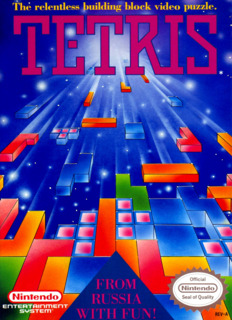Few games can stand the test of time as well as Tetris has. It's a true video game classic.
The basic concept behind Tetris is simple enough that nearly anybody can pick it up and start playing, yet it provides enough of a challenge to keep even veteran Tetris players coming back for more. Here's how it works: blocks of seven different possible shapes will fall from the top of the screen, and it is your job to slide, rotate, and drop these blocks into position as neatly as possible. If you fill an entire row with blocks, that line of blocks will vanish. You can earn more points by clearing two, three, or even four lines at once. Sounds easy enough, right? Well, it is...at first. As you clear more lines, the blocks will start to fall faster, leaving you with less time to react. This leads to you making mistakes, and as your pile of blocks gets higher, you'll have less room to work. It's game over when the blocks pile up to the top of the screen.
The NES version of Tetris offers two different gameplay modes. Mode A is basically an endurance mode: select a starting level (beginners might want to start low, while more advanced players can pick a higher level to kick up the challenge a bit), then try to last as long as you can, earning points along the way. When you lose, if your score is high enough, a rocket will be launched to commemorate your achievement (from a launch pad that is apparently on Red Square right next to St. Basil's Cathedral).
Mode B, on the other hand, has a definite goal: you must clear 25 lines before your blocks hit the top of the screen. In addition to selecting a level, you can also select a "height". This fills the screen with random blocks to the selected height (with 0 being no random blocks, and 5 being filled most of the way to the top), adding an extra layer of difficulty. Instead of rockets, your victory is rewarded with a series of creatures or objects that fly, walk, or otherwise make their way across the screen. If you manage to beat Level 9 at Height 5, you might even see a few familiar faces...
Graphically, Tetris is not all that impressive, even for an NES title. However, it's hard to hold this against the game when you consider that its graphics consist mostly of falling blocks. How great do falling blocks really need to look, anyway?
Tetris offers three different songs for you to listen to while you play, including that one Nutcracker song by that Russian guy. The songs are short and get repetitive quickly. Of course, you'll probably be too busy concentrating on the gameplay to pay any attention to the music, and if it gets too distracting, you can always turn it off. The sound effects are simple bleeps and bloops, which you will also probably not notice because you'll be focusing on where to put that next block.
One of the greatest things about Tetris is that its simple, highly addictive gameplay holds up remarkably well to this day. I've owned the NES version of Tetris for years, and it's one of the few games from that time period that I can still get into today. Another aspect of Tetris that makes it such a great game is its wide appeal. Anybody can enjoy this game, even those who otherwise would never play video games (my mother, for example). And, thanks to a difficulty level that grows with you, beginners and experts alike can play this game over and over again without ever really getting tired of stacking blocks. Tetris is definitely one of the great video game classics. If you own a working NES, and if you don't already have one of the 742 other versions of the game, and if you can find a copy of this, it will make a great addition to your collection.

